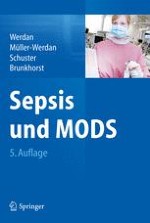Zusammenfassung
Der septische Schock ist mehr als nur ein Kreislaufschock der großen Gefäße! Die Mikrozirkulationsstörung mit Stase senkt die Prognose und ist derzeit keiner gezielten Therapie zugängig. Die therapierefraktäre „zytopathische Hypoxie“ trägt wesentlich zur Energieverarmung der Gewebe bei. Die potenziell reversible septische Kardiomyopathie wird wesentlich durch die diastolische Dysfunktion geprägt. Sie ist am besten mit dem nachlastbezogenen kardialen Herzzeitvolumen („afterload-related cardiac performance“, ACP) zu quantifizieren; die Schwere korreliert mit der Letalität. Die kardiale autonome Dysfunktion manifestiert sich als Herzfrequenzstarre und inadäquat hohe Herzfrequenz, teils erklärt durch die Endotoxin/Schrittmacherkanal(I
f)-Interaktion. Die Therapie folgt der Standardtherapie des septischen Schocks, in Erprobung sind der Kalziumsensitizer Levosimendan, der kurzwirksame β-Blocker Esmolol (Senkung der inadäquat hohen Herzfrequenz) und der Schrittmacherkanalinhibitor Ivabradin.











